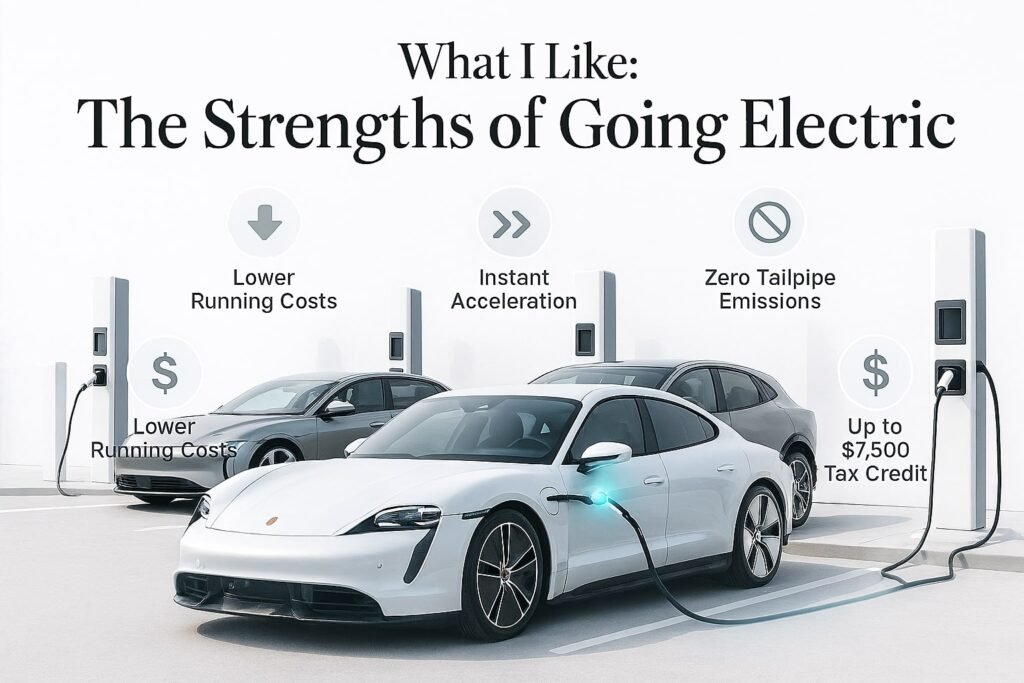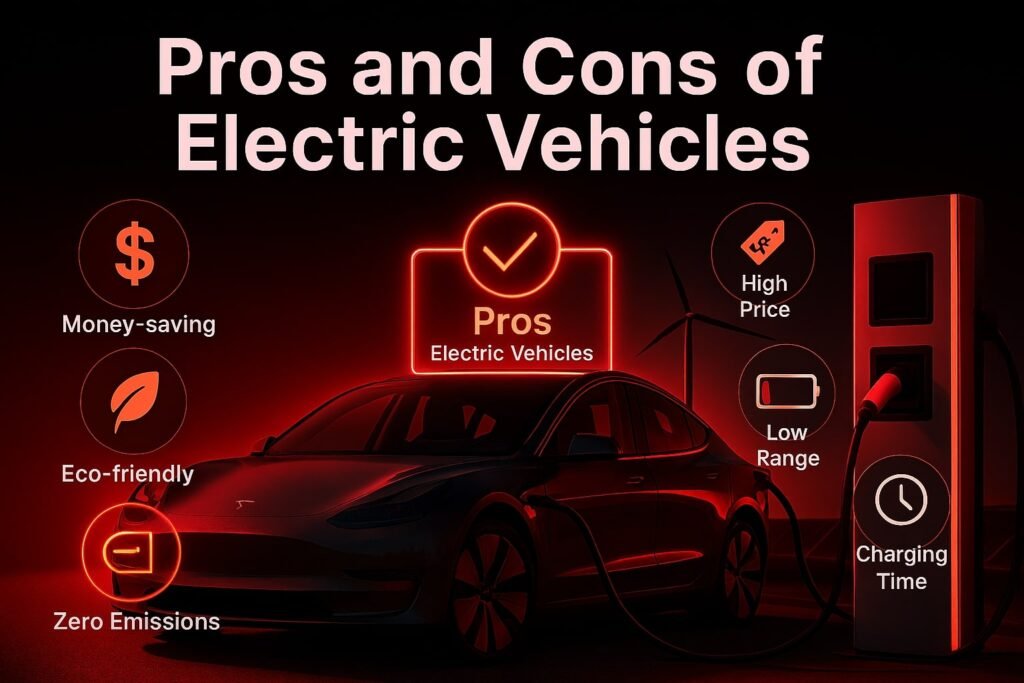Electric vehicles (EVs) are reshaping our roads, offering a blend of high-tech performance and eco-conscious driving. Deciding whether to switch involves weighing significant benefits, like lower fuel costs and zero emissions, against challenges such as higher purchase prices and charging logistics. The pros and cons of electric vehicles show a clear trend towards long-term savings and a better driving experience, but the choice depends heavily on your lifestyle and needs.
This guide provides a comprehensive look at what it truly means to own an EV today. We will cover everything from daily driving experiences to the complex world of battery technology, helping you make an informed decision.
Unpacking the Pros and Cons of Electric Vehicles
The big question is simple: Is an EV right for you? The answer is that it depends on what you value. For many, the financial savings on fuel and maintenance, combined with a superior, quiet driving experience, make EVs an easy choice. For others, concerns about initial cost, driving range, and charging time remain significant hurdles. Let’s break it down.

My Real-World Experience Driving an EV
A few years ago, my family made the switch from a reliable but gas-guzzling SUV to a Kia EV6. The transition was both exciting and a learning curve. The first thing we noticed was the incredible convenience of home charging. We installed a Level 2 home charger in our garage, and waking up to a “full tank” every morning completely changed our routine. No more weekly trips to the gas station, which saved us both time and money—roughly $1,600 in the first year alone.
The driving dynamics were a revelation. The instant torque made city driving feel zippy and responsive. On the highway, the car was serenely quiet, turning long commutes into more peaceful journeys. We even took a few road trips. This required more planning than with our old Internal Combustion Engine (ICE) Vehicle. We used apps to map out DC fast chargers along our route, often stopping for 30 minutes to gain about 200 miles of range. While on a longer trip through a region with sparse non-Tesla chargers, we rented a Tesla Model 3 and found the Tesla Supercharger Network to be exceptionally reliable and fast, highlighting the current disparity in public Charging Infrastructure.
This hands-on experience taught me that owning an EV is about a shift in mindset. It rewards planning and routine but offers substantial benefits in return.
What I Like: The Strengths of Going Electric

Based on my experience and industry data, here are the major advantages.
- Dramatically Lower Running Costs: The cost per mile for electricity is significantly lower than for gasoline. The U.S. Department of Energy confirms this, and my personal experience reflects it. Fewer mechanical parts also mean no oil changes and less frequent brake service, further reducing maintenance expenses.
- Superior Driving Performance: The instant acceleration and silent operation of an EV are hard to overstate. From performance-oriented models like the Porsche Taycan and Lucid Air to mainstream options like the Ford Mustang Mach-E, the ride is smooth, powerful, and engaging.
- Environmental Benefits at the Tailpipe: EVs produce zero tailpipe emissions, which directly contributes to cleaner air in our communities. This is a critical step in reducing urban pollution and our collective carbon footprint.
- Significant Financial Incentives: The Federal Electric Car Tax Credit can reduce the purchase price by up to $7,500 for qualifying vehicles and buyers. Many states and local utilities offer additional rebates for both the vehicle and the installation of a home charger, making the switch more affordable.
Areas for Improvement: The Current Drawbacks
Despite the benefits, there are real challenges to consider when evaluating the pros and cons of electric vehicles.
- Higher Upfront Purchase Price: The initial cost of an EV is typically higher than a comparable gasoline car. Even with incentives, models like the GMC Hummer EV or Rivian R1S carry a premium price tag, which can be a barrier for many buyers.
- Range and Charging Anxiety: While most modern EVs offer 250-350 miles of range, this can be a concern for those who frequently drive long distances. The public Charging Infrastructure is growing, but it’s not yet as ubiquitous as gas stations, and reliability can be inconsistent outside of the Tesla Supercharger Network.
- The Reality of Charging Times: A DC fast charger can add significant range in about 30-40 minutes, but this is still longer than a 5-minute gas station stop. This time adds up on long road trips. Home charging is convenient but slow, taking all night to fully charge an empty battery.
- Impact of Cold Weather: EV batteries are less efficient in cold temperatures. It’s common to see a range reduction of 20-30% in freezing weather, as the battery must work harder to warm itself and the cabin. This is a crucial factor for drivers in northern climates.
- Battery Production and Recycling Concerns: The environmental story of EVs is complex. Battery Production and Recycling involves mining materials like lithium and cobalt, which has environmental and ethical implications. While an EV’s lifetime emissions are lower than an ICE vehicle’s, the manufacturing footprint is larger. The industry is actively working on improving battery chemistry and recycling processes to mitigate these issues.
Comparison: Electric Vehicles vs. ICE Vehicles
To make the pros and cons of electric vehicles clearer, here is a direct comparison with traditional gas-powered cars.
| Feature | Electric Vehicles (EVs) | Internal Combustion Engine (ICE) Vehicles |
|---|---|---|
| Energy Efficiency | High (87–91% according to the U.S. Department of Energy) | Low (16–25% of fuel energy moves the car) |
| Running Costs | Lower (cheaper fuel, less maintenance) | Higher (volatile gas prices, regular maintenance) |
| Purchase Price | Generally higher, offset by incentives like the Federal Electric Car Tax Credit | Generally lower upfront cost |
| Refueling/Charging Time | 30-40 mins for 80% at a DC fast charger; 8-10 hours at home | 5-10 minutes at a gas station |
| Driving Range | Typically 250-350 miles per charge | Typically 350-500 miles per tank |
| Performance | Instant acceleration, quiet operation | Engine noise, vibration, and delayed power delivery |
| Environmental Impact | Zero tailpipe emissions; concerns with Battery Production and Recycling | Tailpipe emissions (CO₂, NOx); impact from oil extraction |
| Infrastructure | Growing Charging Infrastructure, with networks like the Tesla Supercharger Network | Ubiquitous gas stations |
Frequently Asked Questions (FAQ)
Here are direct answers to common questions about the pros and cons of electric vehicles.
1. Are EVs really cheaper to own than gas cars?
Yes, in most cases. While the initial purchase price is higher, the savings on fuel and maintenance often lead to a lower total cost of ownership over 5 to 10 years.
2. How long do EV batteries last?
Most manufacturers guarantee their batteries for 8 years or 100,000 miles. With proper care, modern EV batteries are expected to last for 150,000 to 200,000 miles or more.
3. Can I own an EV if I live in an apartment?
It can be challenging but is increasingly possible. It depends on having access to charging at your building or a reliable public charging station nearby. More apartment complexes are installing Level 2 home chargers for residents.
4. Do electric cars work well in the snow?
Yes, they perform well. Their heavy weight and low center of gravity provide excellent traction. However, be prepared for a noticeable decrease in range during cold weather.
5. Which EV model is best for me?
This depends on your needs. For long-range luxury, a Tesla Model S or Lucid Air excels. For a balance of performance and practicality, a Kia EV6 or Ford Mustang Mach-E is a strong choice. For off-road capability, consider a Rivian R1S. For a great all-around commuter, the Hyundai Kona electric is popular.
6. Is the charging infrastructure reliable?
It’s improving rapidly. The Tesla Supercharger Network is widely considered the most reliable. Other networks are expanding, but users sometimes report issues with broken or occupied chargers. Planning ahead is key.
7. Are EVs truly better for the environment?
Yes, over their full lifecycle. Despite the environmental impact of Battery Production and Recycling, the lifetime emissions of an EV are significantly lower than those of an Internal Combustion Engine (ICE) Vehicle, especially as grids become greener.
Conclusion: Is It Time for You to Go Electric?
The discussion around the pros and cons of electric vehicles is no longer theoretical. EVs are a viable, and often superior, choice for a growing number of drivers. They offer a fantastic driving experience, lower running costs, and the satisfaction of reducing your environmental impact.
However, the decision requires an honest look at your personal circumstances. Consider your daily commute, access to charging, budget, and how often you take long road trips. For many, the benefits already outweigh the drawbacks. For others, waiting a few more years for battery technology to advance and Charging Infrastructure to mature might be the right call.
The electric transition is well underway. The best next step is to test drive a few models—from a Hyundai Kona to a Tesla Model 3—to experience the difference for yourself.
References:
- U.S. Department of Energy (DOE), Office of Energy Efficiency & Renewable Energy: energy.gov
- U.S. Internal Revenue Service (IRS): Credits for New Clean Vehicles Purchased in 2023 and After
- Environmental Protection Agency (EPA): Green Vehicle Guide
- International Energy Agency (IEA): Global EV Outlook 2024


